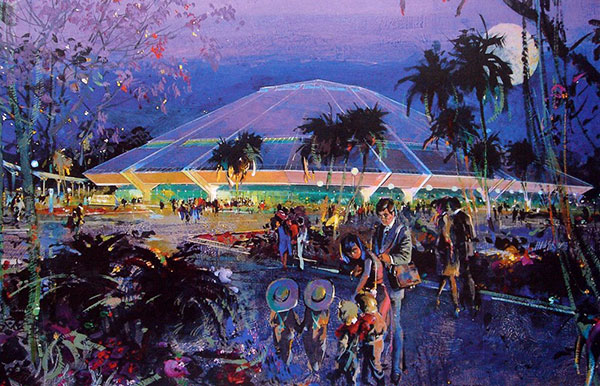
Few extinct attractions receive more praise than Horizons, which charmed visitors to Future World in EPCOT for more than 15 years. Why does Horizons resonate with so many, including some that never rode it? One of my first posts for this site was about what I believe is the “legitimate nostalgia” for Horizons. It embodied the essence of the original EPCOT Center, particularly Future World.
I’m going to dive further into the pavilion to explain why Horizons worked so well. The incredible Horizons Revisited video from the Retro Disney World guys also gives us a new way to experience this classic Disney attraction. In the 1982 book Walt Disney’s EPCOT Center: Creating the New World of Tomorrow, Richard R. Beard describes Horizons this way:
“Rather than emphasizing the inevitable development and perfection of incredibly sophisticated machines of the future, Horizons concentrates on the purpose of the machines. And the purpose is us: how can our lives be enhanced by future technology?”
Horizons did more than show futuristic technologies. Instead, it presented how we would live inside that amazing world. An extended family appeared throughout the ride and connected us to each section. There are small moments of fun combined with grand scenes of space exploration, the desert, and beneath the sea.
A Welcoming Entrance
Let’s journey back to 1983 to explore this brilliant attraction. Horizons offers a complete experience from the moment you stroll towards the pavilion. Its tan exterior might seem quaint compared to the louder designs of Test Track and Mission: Space today, but it worked.
The triangular exterior resembles a World’s Fair pavilion from those events’ heyday. It also looks similar to a pyramid without the pointed finish at the top. The building is large but doesn’t overwhelm you; the architecture of reassurance is in full display with Horizons. The warm, inviting outdoor space draws you towards the experience.
The cylindrical trees outside the pavilion add to the pleasant vibes. This isn’t just a concrete space leading to an ugly queue. Even the small sign in front of the pavilion uses muted colors. This feeling of comfort helps explain Horizons’ enduring popularity.
Disney’s best attractions are like home; they draw you in and work like a powerful drug. Nothing about Horizons’ exterior made you worry. This is an attraction for everyone, and even the smooth automatic doors are cool. You never feel like cattle strolling into Horizons, and that is key to its charm.
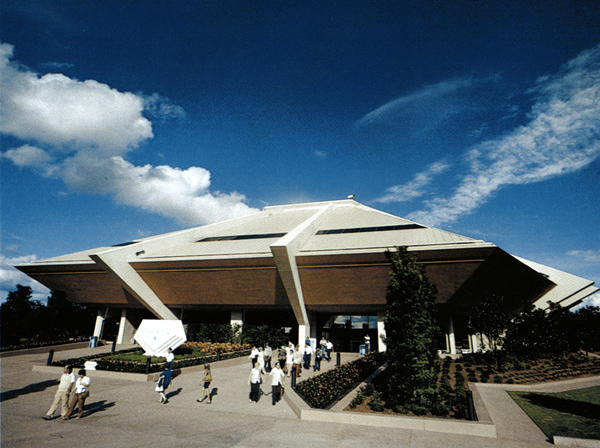
New Horizons
Hearing the friendly tune of George Wilkins’ “New Horizons” as we stroll through the doors offers a great start. The words “if we can dream it, then we can do it” spring from child’s voices in the background of the entryway. Those lyrics also appear on the wall (minus “then”) in large type in the walkway.
This line remains prevalent today, and it’s often misquoted as Walt Disney. Imagineer Tom Fitzgerald penned the words that are still relevant. The way the kids sing “yes we can” connects to the positive message. That phrase especially rings true today.
How you ever looked beyond today into the future? I love the simplicity of this line, which provides Horizons with a mission statement. It’s the promise of the future that drives the narrative. It perfectly summarizes the vision of the optimistic future that was essential in the original EPCOT Center. This “dream of the children” might seem quaint but reminds us not to fall victim to hate. This world can be a pretty amazing place if we break free of our normal habits.
“New Horizons” might seem dated by musical standards, but it fit Horizons’ theme. EPCOT Center gained so much through its attraction music with classic tunes like “Tomorrow’s Child”, “Universe of Energy”, and “Listen to the Land”. They helped make the pavilions warm and inviting places that we wanted to visit.
The closing points of “New Horizons” connect to our current struggle. The idea of a “future built with care” and a “world we all can share” is still a challenge. This optimistic look at our future remains just as relevant now as it was in the 1980s.
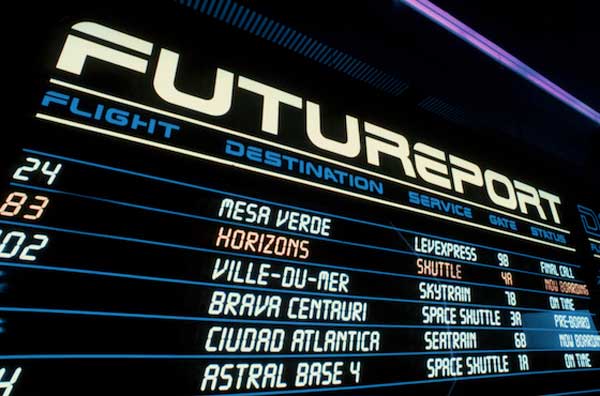
Beginning the Adventure
The comforting feeling continues as we walk through the interesting queue. Horizons had a very high capacity, which gave the impression that it wasn’t popular in later years. Interest had definitely slipped, but it wasn’t as bad as the empty lines indicated.
Taking the time to enjoy the queue is essential. Around the corner is the large Futureport sign, which promises trips to a wide range of destinations. The sign resembles an airport screen with listings of upcoming departures yet also felt a little futuristic. By not moving too far away from the familiar, Horizons still exists within our understanding of the modern world.
Previewing Our Future
After we stroll down the ramp and around the corner, our next step is a convincing effect. The gorgeous images of futuristic settings are set up in a circular view that seems three-dimensional. We see these paintings through windows that only offer part of the picture. It feels like more is just beyond our view. Accompanied by narration, these images preview what is coming in the Tomorrow’s Windows section.
We begin with Sea Castle, a floating city for exploration and relaxation in the Pacific. The next painting shows Mesa Verde and its technologically advanced desert locale. The final shot depicts the space station Brava Centauri, which offers daily shuttle departures. It’s a smart way to prepare us for the adventure.
When we pick our destination at the end of the ride, we will already know the choices. It’s another example of how important an immersive queue can be to a theme park attraction. The heavy lifting can happen early and allow the ride to flow seamlessly.
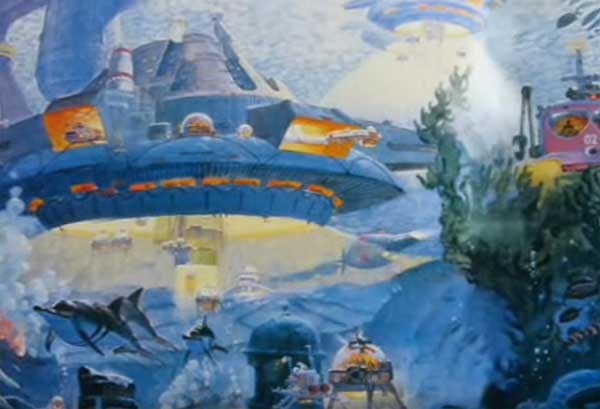
A Clear Perspective at EPCOT Center
It’s time to board our Omnimovers, but they’re different than normal ride vehicles. Attractions like The Haunted Mansion and If You Had Wings turned cars for a specific view. Even so, they often required full sets on both sides.
Horizons lined its Omnimovers along the wall so we faced out towards each scene. This allowed Imagineers to place a lot more into tight spaces of the building using an inventive ride path. We also feel closer to the action since it passes right in front of us.
The vehicles give the impression that you have boarded a new transportation system for a glimpse of our exciting future. World of Motion and Spaceship Earth placed us in cars that seemed familiar; Horizons feels more efficient and comfortable. We barely notice other passengers, especially in the darker scenes. It is our own personal show and not just a way to amuse thousands of tourists.
Bob Holt and Dana Dietrich (voicing the father and mother) are talking directly to us about their lives in the 21st century. Their personal banter is a far cry from the more serious narration from hosts at the nearby Universe of Energy.
The opening scene uses a simple effect of cloud-like images with colors springing out behind them. This transition makes us feel like we are traveling into another time and place. Instead of just dropping us into the action, Horizons allows us to acclimate to the setting. It’s the luxury of having a 15-minute run time. Imagineers could slowly build the mood and don’t need to rush us through to the gift shop. When the music shifts and we look back at the early sci-fi visions, the progression is natural.
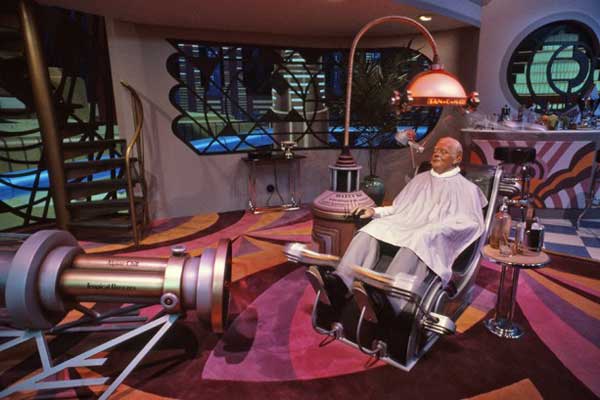
Looking Back at Tomorrow
It’s time to begin the first main section of the ride, which gives us a warm view of past dreams. Looking Back at Tomorrow works because it doesn’t spruce up the effects or include giant show scenes. Instead, the rudimentary images from Georges Méliès’ A Trip to the Moon (1902) and other early views are pitch-perfect. Here is the stuff dreams were made of, as the narrator tells us. The hazy look to these images succeeds because it feels like distant remnants of our past.
Our first animatronic scene is the iconic shot of Jules Verne flying his rocket to the moon. With a dog and chicken joining Verne in the ship, it’s funny without nailing us over the head. The moon even smiles in the background at his ridiculous efforts. This leads us into the next scene of the rocket hitting the face of the moon. The gag reminds us of silly early ideas about outer space and other futuristic ventures.
Three-dimensional drawings of flying machines and other forms of progress follow this scene. We’re slowly reaching for the stars! Not all of these ideas came to pass, including a woman flying on a shark. There is far too much happening in this shot to process all of it in a single ride.
This leads into arguably Horizons’ most iconic scene of the robot butler and other machines helping to provide “easy living”. A variation of the Sherman Brothers’ classic “There’s a Great Big Beautiful Tomorrow” plays in the background, and it’s a nice touch. Horizons was a spiritual sequel to the Carousel of Progress, so referencing that original theme song makes sense. There’s even a black-and-white video of a guy singing it here.
It’s also easy to miss the woman in the bubble bath sitting at the top of the scene. I recognize it now mostly due to the photos from Hoot and Chief’s exploits in exploring this attraction. A man enjoys a haircut downstairs while another robot makes a giant mess in the kitchen. It’s such a busy and clever scene!
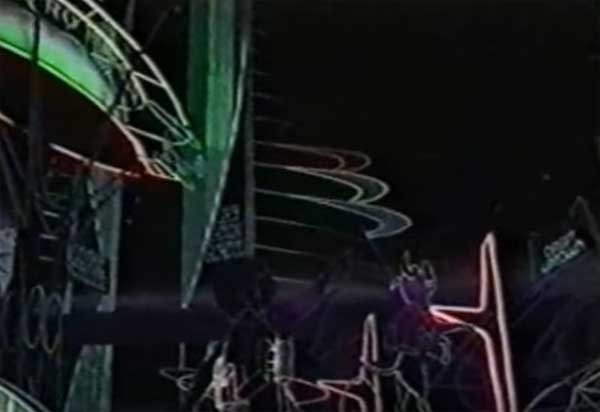
Vintage Movies
It’s time for the matinee, and those movies add a cool vintage feeling. Clips of silent films like Metropolis and Modern Times seem right at home in this attraction. Hanging above the movies are black-light images in several colors that build a purposefully cheap atmosphere.
More ambitious plans for this section were victims to late budget cuts, but it’s hard to notice. The limited sets do not seem out of place and fit the overall theme. Sometimes having less can still lead to great things at theme parks.
This focus on vintage pop culture allows Horizons to avoid feeling too stuffy or dated. There is a universal appeal to these old-time views of science-fiction. They would seem no more out of place today as they do in 1983. The natural progression of these screens moves us slowly towards the more bustling scene that followed.
The room depicting future ideas from the ‘50s is a crowded mess of buildings crammed together into a small space. The music shifts to an upbeat tune, and the sounds of horns blare across the room. It’s not my first choice of a room to get stuck inside, but there’s still plenty to see.
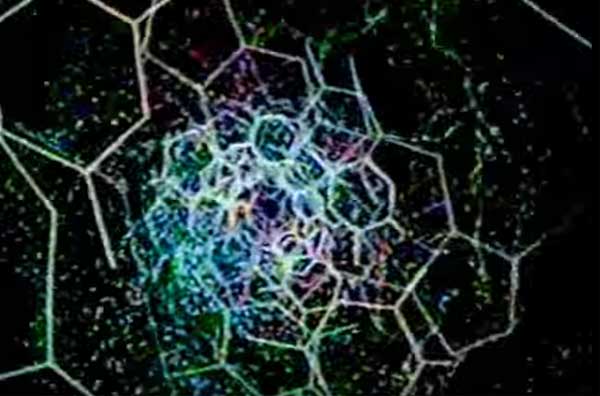
Transitions to Greatness
The next hallway is one of the ride’s most important moments. The transition scenes help build the warm atmosphere more than anything else. The music shifts towards a sense of wonder, and the narrators restate the attraction’s mission statement once again. Tomorrow’s horizons are here today, and we’ll see them soon.
The dim lighting combines with the music to create a relaxing feeling. It also helps build the surprise when we reach the gigantic Omnimax screens. We don’t expect them and are stunned with the massive image in front of us.
This scene reinforces the importance of the side-facing ride vehicles, which open up the giant screens to our view. It’s a more convincing effect than even Soarin’ because all we see is the images in front of us. Flying over the cityscape and catching an up-close view of the microprocessor remains stunning today, even on a home screen.
The impact within the pavilion is truly breathtaking, and it only lasts for a short time. In his book From Horizons to Space Mountain, George McGinnis describes the more ambitious original ideas for this scene, which included three screens and a spiral track past the screens. It’s intriguing to consider what might have been without the budget cuts, but the final version still is impressive.
The Omnimax centerpiece represents the present day and near future, but the technologies wouldn’t be dated today. We no longer use the space shuttle, but the idea of colonies in space remains astounding. Sea exploration still has a long way to go, and up-close views of computer chips are hardly commonplace. Despite just being a giant screen, this presentation still ranks among the most impressive scenes that Disney has ever created for its theme parks.
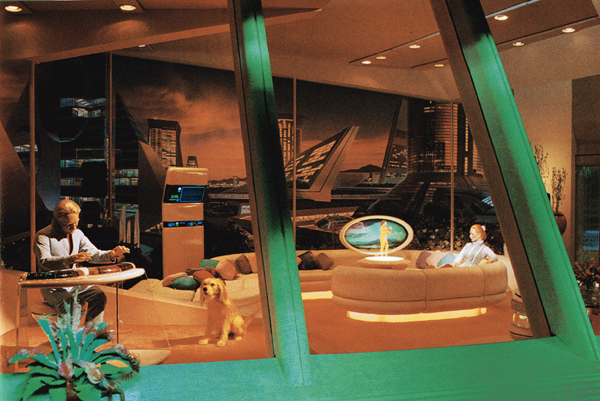
Tomorrow’s Windows
Another effective transition prepares us for the attraction’s second half, known commonly as Tomorrow’s Windows. I can’t say enough again about the importance of the brief moments before a new area. This animatronic-filled section includes some of Horizons’ most memorable scenes and is quite different from what preceded it.
It would be jarring to progress immediately from the Omnimax screen to the next show scenes. The music shifts to a more playful tune as we observe the mother and father in their futuristic home. I wanted to live in this world back when I was a kid, and little has changed over the years.
The idea of viewing these scenes through “windows” is also inspired and fits with the ride system. We’re seeing the future as a tourist, so the slight distance makes sense. The connections to the Carousel of Progress are direct in this scene. There’s even a dog sitting next to the father to match the earlier attraction.
I still love the idea of modifying the final scene in the Carousel of Progress to fit this type of setting. It would help Disney to eliminate the need to stay up to date as technologies changed.
Our next stop is the desert, which introduces the famous smell of oranges. It’s a simple effect yet works brilliantly; some fans are still looking to recreate that scent today. This small touch heightened the scene beyond just seeing the family working in the desert. This scene also uses a clever effect of having characters speak through video screens. We observe one side of the conversation and then see the other person later.
This set-up is used again in the next scene with the beach boy and the daughter’s conversation. Fitzgerald actually played the guy on the video screen. He’s always late. The music becomes more fun in this section, with kids harmonizing in the background. It’s such a pleasant and relaxing environment!
Our next stop is the floating city to meet the class (and a pet seal!) preparing for their diving session. Kids enjoying the technological advances are easy to enjoy for an idealistic kid in the ‘80s. The mother also really loves floating cities and becomes snarky with the father (seaweed!). Even our optimistic narrators get a little grumpy sometimes.
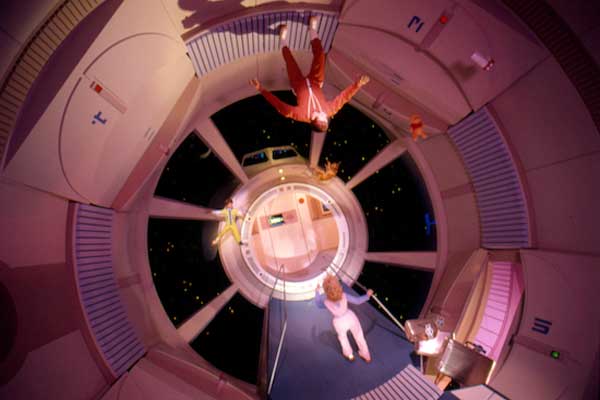
Mysterious New Worlds
Horizons succeeds by giving us a down-to-earth view of futuristic technologies. The undersea exploration vehicles don’t seem too out there, and I’m sure there are more things to discover in our oceans. This tone carries over into the space scenes, which use majestic music to accompany the structures.
Our first glimpses of the space stations do not disappoint. The animation presents a believable circular structure, at least if you don’t consider the huge cost. I’m a space junkie, so these scenes really hit home. The “Space” music clip is one of my favorites from all of Walt Disney World.
The physical sets in front of our vehicles combine with the screen to deliver an effective view of space. Astronauts hang from the sets and help to make the forced perspective come together. The show scene feels gigantic yet does not occupy a vast surface area. The illusion draws you into the scene. We next pass a spacecraft with the attraction’s old Century 3 name waiting in a hangar bay.
The following “window” into the space colony promises a setting where more than just a few could live. A painting from Shim Yokoyama reveals an intricate look at this outer-space world in the background. The shift back and forth between screens and sets works so well here. The large shots transition perfectly to the zero gravity exercise. The fun in that scene also helps to avoid too much grandeur on display.
This section’s highlight depicts the family interacting in zero gravity. The father stands upside down at the top while the son floats high in the room. A dog also sails up high while the mom tried to keep everything together on the bottom. It hearkens back to the focus on the family of the Carousel of Progress.
The human side of the future is essential to Horizons. It reveals how we would function in these environments. The technologies might be amazing, but they mean little without making life better for the people living there.
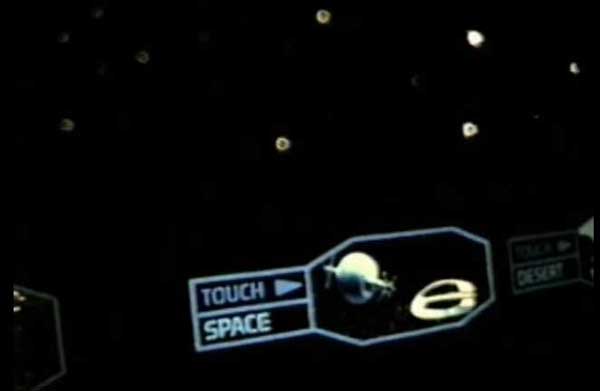
Choose Your Own Ending
After enjoying a birthday party with the entire family, it’s time to make our way home. This transportation is one of Horizons’ most famous elements. We get the chance to pick our flight path back to the Futureport — space, desert, or undersea.
These three habitats are the foundation of the Tomorrow’s Windows section, so it makes sense to involve them once again. The individual screens to simulate the flight might seem quaint in 2022, but they are remarkable in 1983. Even the touch screens to make your selection are amazing.
These traveling-screen scenes are brief yet strike just the right chord. Instead of closing with the birthday party, we get to experience a little more excitement. The three options bring guests back to Horizons to see the choices. Each one has its own good qualities, though the bright desert stands out the most for me.
After passing a GE logo, we step onto the moving platform and back to reality. There was very little product placement in Horizons, which might explain why GE dropped their sponsorship in 1993. It barely intruded into the experience, which was a positive compared to others at EPCOT Center.

The Prologue and the Promise
Originally, there was one more surprise on the way out — the striking mural “The Prologue and the Promise” from Bruce McCall. The gorgeous image of people standing in front of a bright future summarizes Horizons perfectly. The tall, futuristic structure resembles the tower that appeared in the 2015 movie Tomorrowland. That film shared this ride’s ideas of an optimistic future. The mural also includes famous monuments from our past and present. It is a stunning creation. Sadly, GE removed the mural and added a GE logo to heighten their place in the attraction.
The fate of “The Prologue and the Promise” is a perfect metaphor for the ultimate fate of Horizons at EPCOT Center. Business needs took precedence, and it closed for good in early 1999. Mission: Space now occupies the location and provides thrills, but it doesn’t resonate emotionally. I don’t hate the attraction but feel that it could use some adjustments to maximize its potential.
Horizons will live on in our memories and through excellent tributes around the Internet. It remains one of Disney’s greatest creations and my personal favorite. I try to remain hopeful that the spirit of Horizons and EPCOT Center will continue in future attractions. Can Disney lead us to the promise of brighter days?
Sources: From Horizons to Space Mountain by George McGinnis, Walt Disney’s EPCOT Center: Creating the New World of Tomorrow by Richard R. Beard, Horizons – Complete Ultimate Tribute by Martin’s Videos
This post contains affiliate links. Making any purchase through those links supports this site. See full disclosure.
Related Articles: Horizons
Horizons and Legitimate Nostalgia



Sadly, aside from a radom hit here or there. Disneys golden years seem to be over….as long as Iger is still in control. HIS tenure has become 100% soley $$$ focused. Im in support of making money and a capitalist by nature.
Unfortunately, Disney worlds success over the past 40+ years is not referenced in Igers strategy. He continues to nickle and dime these parks to death. Every item is now corner cutting. Proof of that is present in the halfed-ass upgrades to classics, failing maintenance, and last minute changes to quell bad press . -ie 7 dwarfs mine train wasnt even an initial concept but due to grumblings about the lack of excitement the first plan received, they pushed ahead with a drawing board plan that was originally slated to go in there.
The days of Horizons type rides are sadly gone from Disney World. They can justify the cost of th ride vs the return… after several talks with them, i firmly believe that they dont consider the park entrance fee as income to justify a ridea cost ( sarcastically ). They cant show building the ride will give them direct payback like a new store or restaurant etc…
So yes Horizons will be forever in our hearts but unless we see Disney bring another version of michael eisner (like the first 10 years -not later). Disney is on its way to becoming a nicer form of a local amusement park. Far from its heyday years of long ago
I agree that the odds of something like Horizons being created now are slim, and Iger definitely has a different approach to the parks. He’s really good at selling the brand and has been very successful on the movie side. Iger is just not a parks guy. With all that said, I do like what I’ve seen so far with Pandora. It seems to outdo its source material, which is key with that kind of property. I’m trying to stay optimistic for Epcot, but that’s a tougher one for sure. Disney doesn’t seem to have the will to update Future World without bringing in more IP along with it.
Your article prompted me to go to Youtube and watch a ride-through of Horizons. It’s been so long– I last rode it in the early 90’s but remember it so well. The whole thing was utterly entrancing. It made it easy to imagine your own family doing the things shown in the ride. I hope that Disney will not stop making rides with amazing audio-animatronics, they are the masters of the art.
I think we’ll definitely still have audio-animatronics on rides, though they may be more like what we’ve seen in Frozen Ever After and Seven Dwarfs Mine Train. I’ve also read that one of the new Star Wars attractions will have quite a few animatronics, and there should be some (at least one) on the Pandora boat ride. I’m not sure they’ll have the same feel as Horizons, but you never know.
Hey Dan,
Just seeing your article now, though you wrote it nearly a year ago. Hope I’m not too late to the party 🙂
Loved your article, and really really miss Horizons. My first visit to Epcot was in 84 and Horizons immediately struck a chord with me. It’s sad but true, Disney will never make another attraction like it again. It’s a real wonder that it was ever made in the first place,. Walt Disney was such a futurist and was dead and gone… yet the imagineers produced something that would have made him proud.
As much as I wish someone could build an attraction like this today, I understand why they will not. It’s the same reason we don’t have world fairs (at least in the US) anymore. Back in the 60s and even into the 70s there was a real sense of optimism about the future. There was a lot of unrest in those decades, but there was a real vibe that things would get better. People had more trust in corporate America back then, that they really had a good side and were working for the betterment of mankind. (Whether that was ever true is up for debate)
I don’t think today’s cell phone addicted, thrill ride seeking, super hero movie watching visitor would have the same appreciation as us visitors in old days. People are not open minded any more. Probably some folks would immediately label the new Horizons as some liberal Neosocialist dream. It’s a shame a new generation of young folks won’t be inspired the way we were.
Maybe something like it will exist again someday, but not here and now
Chris, I agree that Horizons was a product of the early ’80s, if not earlier considering the influence of the Worlds Fairs like you mention. I’m not convinced people wouldn’t be interested in that type of attraction but with a modern spin. Spaceship Earth is still quite popular, and even Living with the Land is liked by a lot of guests. The template can work, with some adjustments in technology and message. Of course, I know that it’s just a pipe dream. Disney isn’t making rides in the same vein as the EPCOT Center attractions anymore. It’s a different theme park era for sure. Thanks for the great comment!